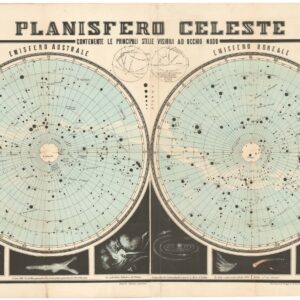A comprehensive visual journey across the visible surface of the moon.
Carte de la Lune Dressee Par L’Abee Th. Moreux…
Out of stock
Description
This wonderful chromolithograph by famous author and astronomer Theophile Moreaux offers an intricate and attractive look at a pristine lunar landscape, with its recognizable features (e.g. the Sea of Tranquility and the Ocean of Storms), along with lesser known elevations and depressions. These features are shown in great detail, with topographic lines outlining major summits and impact craters.
That only one of the moon’s hemispheres is depicted is due to the fact that only one hemisphere is visible from Earth. The reason for this phenomenon, which has given name to the concept ‘the dark side of the moon,’ is that the moon rotates on its axis at the same speed that it orbits Earth. Prior to space flight, it was consequently only the visible 59% of the moon that had been systematically mapped and plotted. The map offered here is almost intuitive, inviting the viewer to really study it in order to understand distinction and delineation. Features such as the Ocean of Storms — the large dark depression occupying about a third of the moon’s visible surface — are not simply delineated on this map, they are associated and linked with other lunar features. This is achieved by means of a simple yellow and light blue color coding (yellow for elevation, blue for depression) and the inclusion of precisely drawn topography, an elegant solution that functions as a visual aid.
The attentive viewer will note certain compositional oddities, such as the fact that the north and south pole have been inverted, but that this is not the case for east and west. Polar regions on the moon are defined as where the axial rotation meets the surface. Why Moreaux decided to depict the moon in this way is somewhat of a mystery. When viewed from Earth, the moon appears at varying angles, depending on where on the planet this observation occurs. However, one would have to view the moon from the South Pole in order for it to appear in the sky in this manner. Being compiled in this way means that at the top of the chart we find the Doerfel Range. This constitutes a visible part of one of several large impact craters on the southern pole and is one of the polar features that is almost continuously exposed to sunlight. Behind and beneath it darkness reigns, and perhaps it was Moreaux’s interest in this darkness that caused him to invert his chart. While at this stage still hypothetical, the presence of ice in the deep and dark crevices of the lunar south pole was thought to be the first scientific clue to extraterrestrial life, a deep interest of Moreaux’s.
Cartographer(s):
Theophile Moreaux (1867-1954) founded an observatory in Bourges, where he also served as professor of mathematics. He was an avid educator and creative thinker, and a member of the respected Légion d’honneur. Among his greatest interests was the vast expanse of space and its infinite possibilities, and he conducted detailed studies of the surfaces of both the moon and Mars. He also published a number of very popular star charts, as well as charts of the moon’s surface.
Among Moreaux’s many celestial interests was the possibility of extraterrestrial life, in any form, although he rejected a popular theory of life on Mars that was prevalent at the time. He authored a number of popular science works that took on big questions like: What happens after death? Why are we here? And is there other life among the stars? These books had enormous popular appeal and with their foundations in science were widely acclaimed as important works of knowledge dissemination and philosophy. In his most celebrated work, La Science Mystérieuse des Pharaons, he demonstrates how, in order to construct the great monuments they did, the ancient Egyptians had to have been able to calculate factors like the Earth’s density, the exact duration of a day and a year, and the distance between the Earth and the Sun. Following his death in 1954, an asteroid (14914) and a large Martian crater were named after him.
Condition Description
Folding map with original covers. Minor loss along one fold.
References
![[Vietnamese Maps of North America: Mexico, Canada, USA]](https://neatlinemaps.com/wp-content/uploads/2022/04/NL-01262-USA_thumbnail-scaled-300x300.jpg)

![[Great European Visit Memorial Flight Game]](https://neatlinemaps.com/wp-content/uploads/2022/01/NL-01012_thumbnail-scaled-300x300.jpg)
![[Title in Russian] Russian Empire in the 18th Century (European Section)](https://neatlinemaps.com/wp-content/uploads/2020/04/NL-00822_Thumbnail-300x300.jpg)
![[Title in Russian] Russian Empire in the 18th Century (European Section)](https://neatlinemaps.com/wp-content/uploads/2020/04/NL-00822-scaled-300x300.jpg)